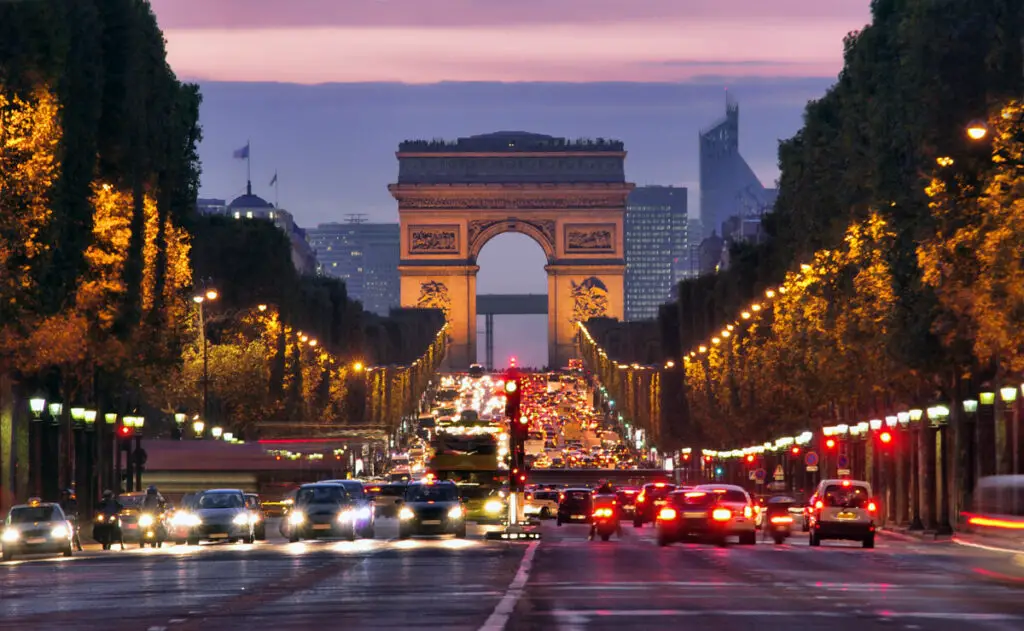If you have ever watched Tour de France, you probably wondered why they don’t race on the last stage. Are they too tired after 20 days of racing? Is it not allowed to race? Does it even count as a stage?
Cyclists do not race the last stage of the Tour de France because of the tradition and the course profile. Tradition dictates that the last stage is dedicated to celebrating victory. The course is also too flat for the riders to be able to create significant time gaps.
It’s hard to understand the logic behind it for the first-time viewer. I agree it doesn’t make much sense at first, so I will try my best to explain, so you will go ‘yeah, I get it’ the next time you watch Tour de France.
Can yellow jersey change hands on the last day?
There is absolutely no rule that prevents riders from taking a leader’s jersey on the last day. The last stage counts towards the general classification as any other stage.
However, ever since the last stage became ceremonial, it’s expected that the yellow jersey is not attacked and that the wearer of it can enjoy a peaceful day in front of thousands of fans.
It’s a gentleman’s agreement between riders. I’m sure every year, some of them would like to attack and try to change the general classification, but they never do. They understand that there’s an agreement that needs to be honored.
Even if a rider thinks about attacking, he has two arguments in mind that make him change his mind. Those are tradition and course profile – neither favors the attack.
Tradition
For a long time, riders in the Tour de France battled till the very end. It wasn’t until 1975 that the format we know today was introduced.
Since the inaugural edition, the race finished in Paris, but until 1975 the last stage was just like the others. Riders battled for stage wins as well as seconds in the overall standings. For a long time, the final stage was an individual time trial, so the changes in the general classification were almost expected.
The first Tour de France was held in 1903. For more than 70 years, cyclists fought for the yellow jersey even on the last day.
In 1975 the organizers tried a new format — a stage with 25 laps through the heart of the city with the finish on the majestic Champs-Elysees.
It was an instant success.
Spectators were thrilled to see their heroes for more than just a few seconds. The television footage was incredible, thanks to the beautiful ambient. And most importantly, the riders enjoyed the electrifying atmosphere created by tens of thousands of fans gathered on Paris’ most famous avenue.
On the first Champs-Elysees stage, the gentleman’s agreement of not attacking was not yet in place, but due to the course profile, the group finished together. Over the years, the tradition has grown stronger, younger riders embraced it and are honoring it to this day.
Nowadays, it has become so embedded in the cycling culture that cycling fans don’t even think about it. It just exists. Some people call for a change every year, but I don’t see it changing anytime soon.
Course profile
Perhaps the course profile is the main reason we don’t see any attacks on the yellow jersey in the last stage. It helped create a tradition because if the course had allowed successful attacks in the early years, the tradition would probably not have developed at all.
I don’t know if you have ever checked the map of Paris, but it’s not very hilly. Champs-Elysees have a total elevation of 22 meters (72 feet) over almost 2 kilometers (1.24 mi). Not an ideal terrain for a successful attack.

Nowadays, the last stage is slightly different from the early years. It starts outside Paris, but it’s still mainly flat. Attacks are still difficult to succeed, so we do not even see many attempts. The first part of the stage is intended for a celebration and the real racing for a stage win begins when the group reaches Champs-Elysees.
The profile of the last stage suits sprinters who battle for the prestigious stage win, while the general classification riders just ride with the group and make sure they get the same time as the other riders. Even if one of them tried to attack, sprinters would quickly chase him down as they treat this stage as a sprint of the season.
What would happen if a cyclist attacked on the last stage?
As mentioned before, no rule prevents an attack in the last stage. So what would happen if someone tried to break the gentleman’s agreement?
In 2005, we saw an event like this. Alexandre Vinokourov successfully attacked on Champs-Elysees and won the final stage. To this day, he’s the only rider who managed to beat the sprinters on the last stage.
While Vinokourov might not be the most popular guy in cycling, the attack in 2005 is not the reason for that. In fact, he has not received much criticism for his actions, and one key factor contributes to this. He was sixth in the general classification and moved to fifth after the win. The yellow jersey was not under threat, so the attack was able to succeed.
Alexandre Vinokourov is the only rider who successfully attacked on the Champs-Elysees.
If a rider attacked the yellow jersey on the last stage, the leader’s team would chase him down immediately. If they would struggle to catch him, some other team might help them.
Even if the attack succeeded, the rider would not do himself any favor. It’s career suicide. The cycling world would despise him, sponsors might leave him due to bad publicity and other cyclists would not help him in any other race. He would become an outlaw.
Under what conditions can you take over the yellow jersey?
There is only one scenario in which the yellow jersey would change hands on the last day.
If the wearer of the yellow jersey injured himself so badly that he could not finish the stage, he would lose the yellow jersey. The last stage counts as all the others, so if you can’t finish it, you didn’t finish the race.
If the leader of the race had any other problems on the last day, the peloton would wait. There were a few times when the leader had mechanical problems or fell, but the group waited for him every time.
It’s a gentleman’s agreement that the yellow jersey is not attacked on the last stage, no matter what happens to him. Every cyclist knows that the general classification cannot be changed on the last day, so if he wants to take the yellow jersey, he has to do it by stage 20.
Has the yellow jersey ever changed hands on the last stage?
Three times in the history of the Tour de France, a rider has taken the yellow jersey on the final stage. Twice before the introduction of the ceremonial final stage and once after.
‘But you said that yellow jersey can’t change hands on the last stage.’
I know, I know. Let me explain.
In 1989 the race organizers wanted to try something new. After 14 years of the relatively boring final stage, they wanted to see some proper racing again. The last stage was, therefore, a time trial on Champs-Elysees.
They hit the nail on the head with their decision, as the finish of the Tour de France in 1989 is considered one of the most interesting in history.
Local hero Laurent Fignon entered the last stage with a 50-second advantage over American Greg LeMond. But the latter was a better time trialist and beat his rival by 58 seconds. He overtook him in the general classification by only 8 seconds, which is still the smallest gap in history.
The following year, the organizers dropped the final time trial and reintroduced the traditional ceremonial stage. This has remained until today.
Do all Grand Tours have the same ‘rule’?
Tour de France is the biggest race in the world, so it’s always setting the trends. However, the trend of the ceremonial final stage has not caught on in other Grand Tours.
La Vuelta a España has a similar final stage on the streets of Madrid from time to time, but it also has a final time trial fairly often. The ceremonial final stage doesn’t have a traditional status, as organizers try to find the right balance between the celebration and exciting battle till the end.
Only Tour de France has a ceremonial final stage every year.
Giro d’Italia wants to distance itself the most from the ceremonial format of the final stage. An important factor is that they don’t have a traditional city to host the last stage, like the Tour de France and La Vuelta a España. Every year the finish is hosted by a different Italian city, which of course wants to see proper racing.
Even the ‘classic’ final stages are not ceremonial on the Italian race. They are usually much longer than the final stages of the other two races, and the attacks can be followed right to the end. There is no gentleman’s agreement between the riders and no tradition that says you shouldn’t attack the lead rider.
Last Stage of Tour de France
Frequently asked questions
Can other jerseys change hands on the final stage?
Only the green jersey for best sprinter can change hands in the last stage. It’s a flat stage for sprinters with many points available at the finish line. There is no agreement that the green jersey should be respected as the yellow jersey, as not attacking it would be hard. Every sprinter who competes for a stage win indirectly also attacks the green jersey.
How long is the last stage?
The last stage is usually between 110-130 kilometers long (70-80 miles). The first part is dedicated to celebrating victory and the real racing only starts when cyclists reach the Champs-Elysees. There they complete eight laps of almost 7 kilometers (4 miles).

